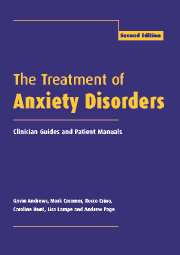Book contents
- Frontmatter
- Contents
- List of authors
- Preface to the second edition
- Abbreviations
- 1 Read me
- 2 General issues in anxiety disorders
- 3 General issues in treatment: Clinician Guide
- 4 Panic disorder and agoraphobia: Syndrome
- 5 Panic disorder and agoraphobia: Treatment
- 6 Panic disorder and agoraphobia: Clinician Guide
- 7 Panic disorder and agoraphobia: Patient Treatment Manual
- 8 Social phobia: Syndrome
- 9 Social phobia: Treatment
- 10 Social phobia: Clinician Guide
- 11 Social phobia: Patient Treatment Manual
- 12 Specific phobias: Syndrome
- 13 Specific phobias: Treatment
- 14 Specific phobias: Clinician Guide
- 15 Specific phobias: Patient Treatment Manual
- 16 Obsessive-compulsive disorder: Syndrome
- 17 Obsessive-compulsive disorder: Treatment
- 18 Obsessive-compulsive disorder: Clinician Guide
- 19 Obsessive-compulsive disorder: Patient Treatment Manual
- 20 Generalized anxiety disorder: Syndrome
- 21 Generalized anxiety disorder: Treatment
- 22 Generalized anxiety disorder: Clinician Guide
- 23 Generalized anxiety disorder: Patient Treatment Manual
- 24 Posttraumatic stress disorder: Syndrome
- 25 Posttraumatic stress disorder: Treatment
- 26 Posttraumatic stress disorder: Clinician Guide
- 27 Posttraumatic stress disorder: Patient Treatment Manual
- 28 Conclusions
- References
- Index
12 - Specific phobias: Syndrome
Published online by Cambridge University Press: 05 August 2016
- Frontmatter
- Contents
- List of authors
- Preface to the second edition
- Abbreviations
- 1 Read me
- 2 General issues in anxiety disorders
- 3 General issues in treatment: Clinician Guide
- 4 Panic disorder and agoraphobia: Syndrome
- 5 Panic disorder and agoraphobia: Treatment
- 6 Panic disorder and agoraphobia: Clinician Guide
- 7 Panic disorder and agoraphobia: Patient Treatment Manual
- 8 Social phobia: Syndrome
- 9 Social phobia: Treatment
- 10 Social phobia: Clinician Guide
- 11 Social phobia: Patient Treatment Manual
- 12 Specific phobias: Syndrome
- 13 Specific phobias: Treatment
- 14 Specific phobias: Clinician Guide
- 15 Specific phobias: Patient Treatment Manual
- 16 Obsessive-compulsive disorder: Syndrome
- 17 Obsessive-compulsive disorder: Treatment
- 18 Obsessive-compulsive disorder: Clinician Guide
- 19 Obsessive-compulsive disorder: Patient Treatment Manual
- 20 Generalized anxiety disorder: Syndrome
- 21 Generalized anxiety disorder: Treatment
- 22 Generalized anxiety disorder: Clinician Guide
- 23 Generalized anxiety disorder: Patient Treatment Manual
- 24 Posttraumatic stress disorder: Syndrome
- 25 Posttraumatic stress disorder: Treatment
- 26 Posttraumatic stress disorder: Clinician Guide
- 27 Posttraumatic stress disorder: Patient Treatment Manual
- 28 Conclusions
- References
- Index
Summary
There is broad agreement between ICD-10 and DSM-IV regarding specific (or isolated) phobias. Distilling from these two diagnostic systems, the major features of a phobia are:
1. A stimulus-bound fear reaction that is
2. distressing to the point of causing emotional, social, or occupational disruptions,
3. recognized as excessive or unreasonable, and
4. leads to avoidance or intense anxiety upon exposure to the feared stimulus.
From studies of the diagnostic reliabilities it is apparent that specific phobias are readily identified but it is difficult to determine the threshold of impairment to define when such fears become phobias (Di Nardo et al., 1983). One of the strengths of the DSM system is that it explicitly encourages subtyping of the specific phobias into four categories. It specifically identifies phobias as:
1. Animal.
2. Natural environment (e.g., heights, storms, water).
3. Blood, injection, and injury.
4. Situational (e.g., planes, elevators, enclosed places).
It also mentions (but includes in an “other” category) phobias of situations that may lead to choking, vomiting, or contracting an illness. At present, the prognostic value of subtyping is not clear. Although individuals with one subtype of phobia are likely to have other fears from within the same subtype, they are also likely to have other specific phobias (Hofmann et al., 1997). Nevertheless, the value of subtyping is not without its merits, and in the case of blood, injection, and injury phobia there are distinct treatment implications of the unique properties of this disorder (Marks, 1988;Page, 1994b). Kleinknecht and Lenz (1989) divided blood–injury phobics on the basis of fear and propensity to faint and were able to identify a subgroup who fainted in response to blood or injury but reported no significant fear. Interestingly, an association was found between parents and children for fainting but not for fear, suggesting separate etiologies. Presently, neither of the major diagnostic systems make mention of the role of fainting, even though this is an important consideration when tailoring treatment to the individual (Öst et al., 1984a;Öst and Sterner, 1987;Page, 1991a). In the majority of cases diagnosis is relatively straightforward but it is made easier by structured diagnostic interviews. The Anxiety Disorders Interview Schedule – Revised (ADIS-R) and the Composite International Diagnostic Interview (CIDI) both provide reliable assessments of specific phobias (Page, 1991b;Peters and Andrews, 1995).
- Type
- Chapter
- Information
- The Treatment of Anxiety DisordersClinician Guides and Patient Manuals, pp. 261 - 270Publisher: Cambridge University PressPrint publication year: 2002



